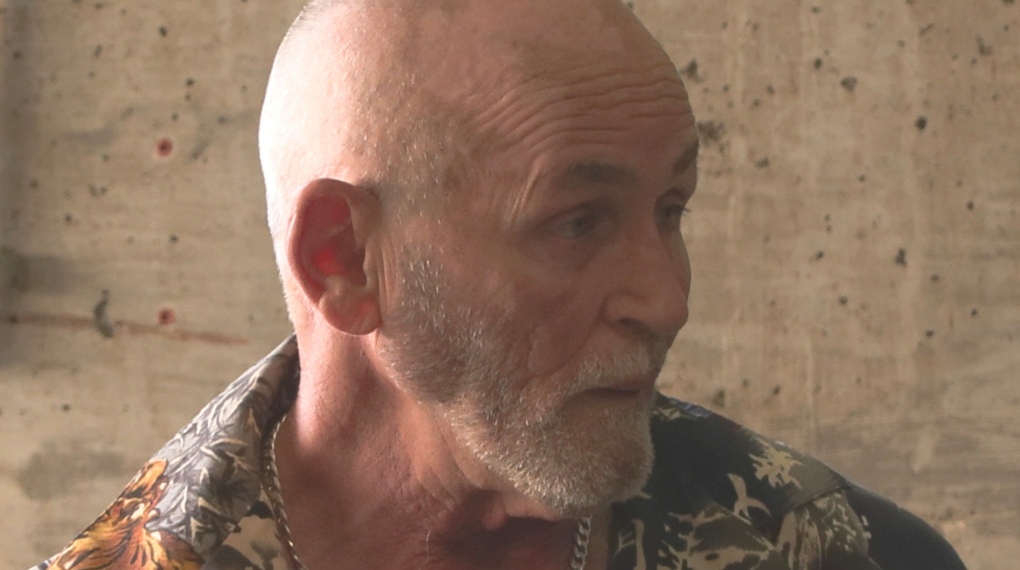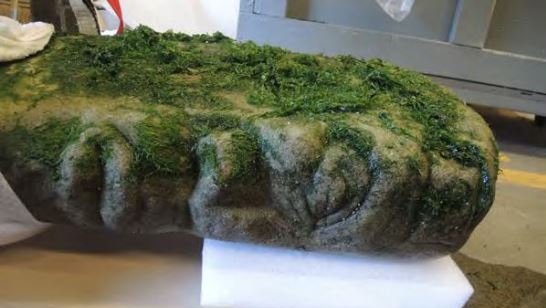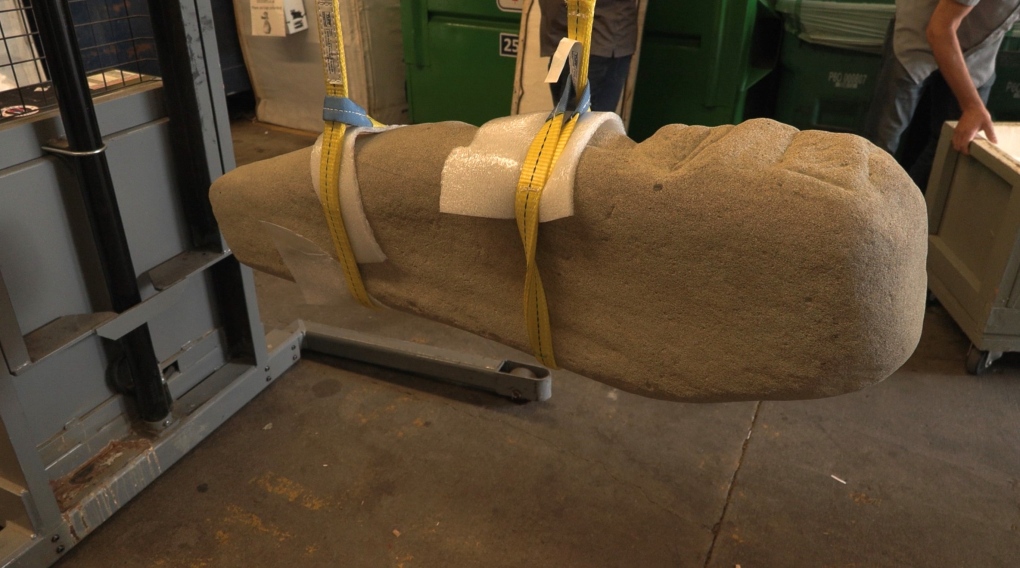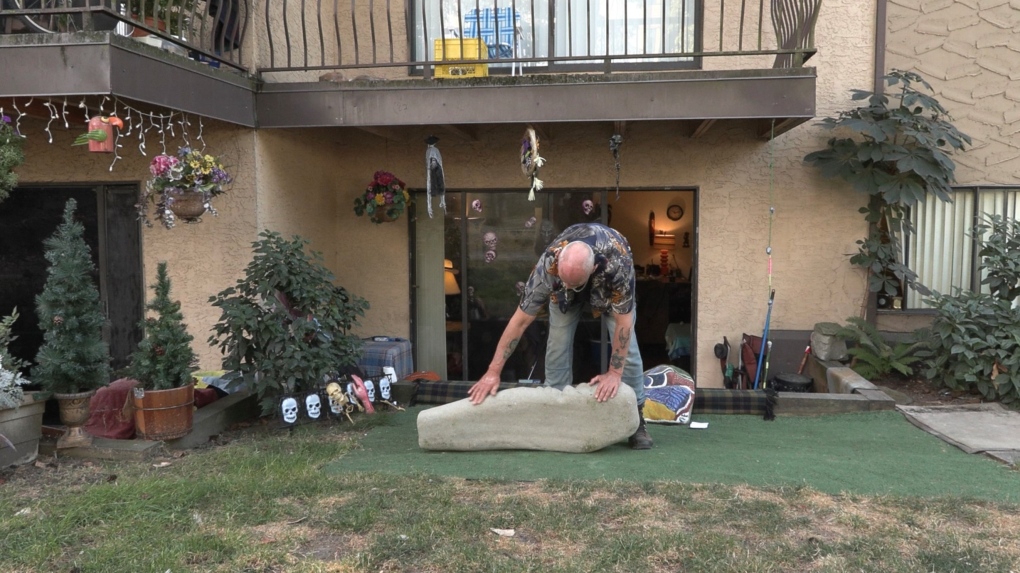Royal B.C. Museum apologizes after 2017 carving declared ancient Indigenous artifact
The Royal British Columbia Museum apologized Tuesday and admitted for the first time that one of its artifacts is not, in fact, a centuries-old Indigenous stone monument, as museum curators had claimed.
Rather, the stone was carved five years ago by a Victoria hobbyist with no ties to local Indigenous culture, despite the museum's grand assertions about the stone's historic significance to the First Peoples of Vancouver Island.
The museum clung to that ancient-origin story until Tuesday, when staff met with the local carver in the museum's underground loading dock and forklifted the stone into the back of his car to finally take home.
In a letter of apology, museum CEO Alicia Dubois said she was "relieved and pleased" to see the artwork returned to its rightful owner.
"I would like to express my gratitude for your patience as we navigated this unfamiliar territory and extend sincere apologies for the errors made during the process," Dubois wrote.
"I assure you that as a team, we have learned from this experience and are taking concrete measures to ensure similar errors are not made in future."
ORIGINS OF THE CARVING
It was raining in Victoria in January 2017 when Ray Boudreau, a night watchman for a security company, went to the beach with the carpenter's hammer and chisel he kept in the trunk of his car.
He had tooled leather bibles before, but never solid rock. Nonetheless, he found a piece of sandstone – weighing in excess of 100 kilograms – at the bottom of the bluff and started carving the human face that would go on to dupe researchers at B.C.'s foremost repository of natural and human history.
When Boudreau returned to the beach days later to finish his carving, the rock was gone. He figured someone took it, but more likely it was carried out to sea by a surging winter tide.
That's where it was recovered three years later by Grant Keddie, then curator of the Royal B.C. Museum's Indigenous collections and repatriation department, after receiving a tip about a strange carving spotted in the surf at low tide.
 Artist Ray Boudreau at the Royal B.C. Museum on Tuesday, Sept. 13, 2022. (CTV News)
Artist Ray Boudreau at the Royal B.C. Museum on Tuesday, Sept. 13, 2022. (CTV News)
'VERY SPECIAL RITUAL STONE PILLAR'
Internal communications obtained by CTV News show that Keddie and his team quietly set to work on restoring the carving and preparing a permanent gallery display for the "ritual stone pillar."
The planned installation would feature the carving set upright within a display case to "show the figure as it would have been seen centuries ago, partly in the ground," Keddie wrote in an email to a colleague.
The partially redacted documents, obtained through B.C.'s access-to-information law, proved the museum disregarded warnings about the carving's authenticity and pressed ahead with plans to present the stone as a watershed discovery for Indigenous culture in the province.
 The stone carving, shortly after it was recovered in July 2020, at the Royal B.C. Museum. (RBCM)
The stone carving, shortly after it was recovered in July 2020, at the Royal B.C. Museum. (RBCM)
Six months later, the museum issued a news release and published a lengthy article announcing the discovery of a "very special ritual stone pillar" that had been hewn centuries ago by the Indigenous inhabitants of southern Vancouver Island.
The announcement made national headlines and stoked excitement in the archaeological community.
But within 48 hours of the announcement, Boudreau, the carver, showed CTV News photos of his carving, which bore a striking resemblance to the carving the museum believed was used centuries ago "to change the weather" during seasonal ceremonies.
When CTV News published Boudreau's account of the carving later that day, the museum immediately scrubbed all mention of the discovery – including its press release, photographs and a lengthy essay written by Keddie, the curator – from its website without explanation.
Indeed, in the months that followed, all of Keddie’s research would be erased from the museum website, along with his employee profile and contact information.
Keddie, who had served as a leading curator at the museum for decades, was also removed from the B.C. government's staff directory, which lists contact information for current provincial employees.
 The carving is lifted into the back of a vehicle at the Royal B.C. Museum on Tuesday, Sept. 13, 2022. (CTV News)
The carving is lifted into the back of a vehicle at the Royal B.C. Museum on Tuesday, Sept. 13, 2022. (CTV News)
Spokespersons for the museum declined to comment on Keddie's departure on Tuesday, saying only that it was a human resources matter.
At no point during the two years when the carving sat in a crate in the museum's basement did anyone at the institution try to contact Boudreau about his claim.
'A LONG TIME COMING'
Keddie's departure was just the latest in a series of recent, high-profile exits among museum staff. Those exits include the ouster of president and CEO Jack Lohman amid a third-party investigation into workplace racism and mismanagement, and the voluntary departures of two Indigenous collections curators.
Janet Hanuse, the museum's vice-president of engagement and implementation of the Declaration on the Rights of Indigenous Peoples Act, would not say specifically what errors were made in the curatorial process or how the final determination of the artifact's origin was reached.
"It underwent some sort of investigation but then it stopped," Hanuse told CTV News. "There's been a lot of attention around it and I personally don't like things left unfinished so I'm happy to see closure."
 Ray Boudreau takes his carving home from the Royal B.C. Museum for the first time since creating it in 2017. (CTV News)
Ray Boudreau takes his carving home from the Royal B.C. Museum for the first time since creating it in 2017. (CTV News)
Leaving the museum with his carving Tuesday, Boudreau said he had "mixed feelings" about finally getting the artwork back all these years later, but he vowed to finish the carving as he intended.
"It's been a long time coming," Boudreau said. "But it would have been cool to visit it here at the museum and say, 'I did that.'"
CTVNews.ca Top Stories

BREAKING Prime Minister Justin Trudeau's plane lands near Donald Trump's Mar-a-Lago estate
Prime Minister Justin Trudeau's plane landed in West Palm Beach, Fla., this evening, not far from where incoming U.S. president Donald Trump's transition team is based at his Mar-a-Lago estate. The Prime Minister's Office is refusing to comment on whether the two are meeting.
'Mayday! Mayday! Mayday!': Details emerge in Boeing 737 incident at Montreal airport
New details suggest that there were communication issues between the pilots of a charter flight and the control tower at Montreal's Mirabel airport when a Boeing 737 made an emergency landing on Wednesday.
Hit man offered $100,000 to kill Montreal crime reporter covering his trial
Political leaders and press freedom groups on Friday were left shell-shocked after Montreal news outlet La Presse revealed that a hit man had offered $100,000 to have one of its crime reporters assassinated.
Cucumbers sold in Ontario, other provinces recalled over possible salmonella contamination
A U.S. company is recalling cucumbers sold in Ontario and other Canadian provinces due to possible salmonella contamination.
John Herdman resigns as head coach of Toronto FC
John Herdman, embroiled in the drone-spying scandal that has dogged Canada Soccer, has resigned as coach of Toronto FC.
Musk joins Trump and family for Thanksgiving at Mar-a-Lago
Elon Musk had a seat at the family table for Thanksgiving dinner at Mar-a-Lago, joining President-elect Donald Trump, Melania Trump and their 18-year-old son.
Billboard apologizes to Taylor Swift for video snafu
Billboard put together a video of some of Swift’s achievements and used a clip from Kanye West’s music video for the song “Famous.”
Trudeau says no question Trump is serious on tariff threat
Prime Minister Justin Trudeau says incoming U.S. president Donald Trump's threats on tariffs should be taken seriously.
In a shock offensive, insurgents breach Syria's largest city for the first time since 2016
Insurgents breached Syria's largest city Friday and clashed with government forces for the first time since 2016, according to a war monitor and fighters, in a surprise attack that sent residents fleeing and added fresh uncertainty to a region reeling from multiple wars.


































